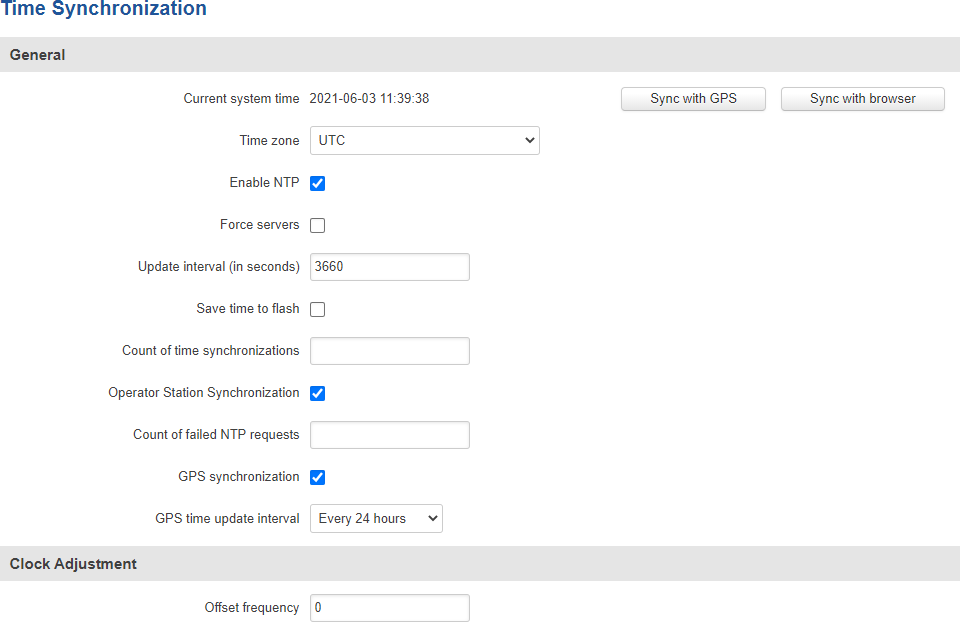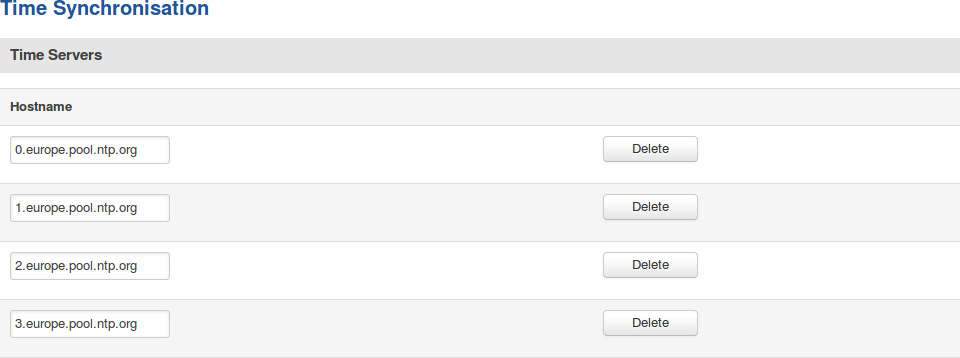|
|
| (9 intermediate revisions by 4 users not shown) |
| Line 1: |
Line 1: |
| ==Summary==
| | {{Template: Networking_rut_manual_ntp |
| | | <!------------------------DEVICE-----------------------> |
| '''Network Time Protocol (NTP)''' is a networking protocol for clock synchronization between computer systems over packet-switched, variable-latency data networks. This chapter is an overview of the NTP service section of [[Network products|RUTxxx routers]].
| | | name = RUT230 |
| | | | series = RUT2XX |
| ==General==
| | <!----------------------SEPARATORS---------------------> |
| | | | gps = 1 |
| The '''Time Synchronization''' section is used to configure general router time settings, like selecting the local time zone, setting a time update interval, synchronizing the time, etc.
| | }} |
| | |
| [[File:Services ntp general v2.png]]
| |
| | |
| {| class="wikitable" | |
| |+
| |
| ! style="width: 250px; border: 1px solid white; border-bottom: 2px solid #0054A6; background: white; color: #0054A6; text-align: left;" | FIELD NAME
| |
| ! style="width: 250px; border: 1px solid white; border-bottom: 2px solid #0054A6; background: white; color: #0054A6; text-align: left;" | VALUE | |
| ! style="width: 579px; border: 1px solid white; border-bottom: 2px solid #0054A6; background: white; color: #0054A6; text-align: left;" | DESCRIPTION
| |
| |-
| |
| ! style="border: 1px solid white; border-bottom: 2px solid #E8E8E8; text-align: left; vertical-align: top; background: white;" | Current system time
| |
| | style="border: 1px solid white; border-bottom: 2px solid #E8E8E8; text-align: left; vertical-align: top; background: white;" | time; Default: '''current time'''
| |
| | style="border: 1px solid white; border-bottom: 2px solid #E8E8E8; text-align: left; vertical-align: top; background: white;" | Current local time of the router
| |
| |-
| |
| ! style="border: 1px solid white; border-bottom: 2px solid #E8E8E8; text-align: left; vertical-align: top; background: white;" | Time zone
| |
| | style="border: 1px solid white; border-bottom: 2px solid #E8E8E8; text-align: left; vertical-align: top; background: white;" | time zone; Default: '''UTC'''
| |
| | style="border: 1px solid white; border-bottom: 2px solid #E8E8E8; text-align: left; vertical-align: top; background: white;" | Time zone of the country where the router is located
| |
| |-
| |
| ! style="border: 1px solid white; border-bottom: 2px solid #E8E8E8; text-align: left; vertical-align: top; background: white;" | Enable NTP
| |
| | style="border: 1px solid white; border-bottom: 2px solid #E8E8E8; text-align: left; vertical-align: top; background: white;" | yes {{!}} no; Default: '''no'''
| |
| | style="border: 1px solid white; border-bottom: 2px solid #E8E8E8; text-align: left; vertical-align: top; background: white;" | SO/IEC 3166 alpha2 country codes as defined in ISO 3166-1 standard
| |
| |-
| |
| ! style="border: 1px solid white; border-bottom: 2px solid #E8E8E8; text-align: left; vertical-align: top; background: white;" | Force servers
| |
| | style="border: 1px solid white; border-bottom: 2px solid #E8E8E8; text-align: left; vertical-align: top; background: white;" | yes {{!}} no; Default: '''yes'''
| |
| | style="border: 1px solid white; border-bottom: 2px solid #E8E8E8; text-align: left; vertical-align: top; background: white;" | Forces unreliable NTP servers
| |
| |-
| |
| ! style="border: 1px solid white; border-bottom: 2px solid #E8E8E8; text-align: left; vertical-align: top; background: white;" | Update interval (in seconds)
| |
| | style="border: 1px solid white; border-bottom: 2px solid #E8E8E8; text-align: left; vertical-align: top; background: white;" | integer; Default: '''3660'''
| |
| | style="border: 1px solid white; border-bottom: 2px solid #E8E8E8; text-align: left; vertical-align: top; background: white;" | How often the router updates systems time
| |
| |-
| |
| ! style="border: 1px solid white; border-bottom: 2px solid #E8E8E8; text-align: left; vertical-align: top; background: white;" | Save time to flash
| |
| | style="border: 1px solid white; border-bottom: 2px solid #E8E8E8; text-align: left; vertical-align: top; background: white;" | yes {{!}} no; Default: '''yes''' | |
| | style="border: 1px solid white; border-bottom: 2px solid #E8E8E8; text-align: left; vertical-align: top; background: white;" | Saves last synchronized time to flash memory | |
| |-
| |
| ! style="border: 1px solid white; border-bottom: 2px solid #E8E8E8; text-align: left; vertical-align: top; background: white;" | Count of time synchronizations | |
| | style="border: 1px solid white; border-bottom: 2px solid #E8E8E8; text-align: left; vertical-align: top; background: white;" | integer; Default: " "
| |
| | style="border: 1px solid white; border-bottom: 2px solid #E8E8E8; text-align: left; vertical-align: top; background: white;" | Total amount of times that router will do the synchronization.
| |
| '''NOTE:''' If left blank - the count will be infinite
| |
| |-
| |
| ! style="border: 1px solid white; border-bottom: 2px solid #E8E8E8; text-align: left; vertical-align: top; background: white;" | GPS synchronization
| |
| | style="border: 1px solid white; border-bottom: 2px solid #E8E8E8; text-align: left; vertical-align: top; background: white;" | yes {{!}} no; Default: '''no'''
| |
| | style="border: 1px solid white; border-bottom: 2px solid #E8E8E8; text-align: left; vertical-align: top; background: white;" | Enables periodic time synchronization of the system using the GPS module (does not require internet connection)
| |
| |-
| |
| ! style="border: 1px solid white; border-bottom: 2px solid #E8E8E8; text-align: left; vertical-align: top; background: white;" | Offset frequency
| |
| | style="border: 1px solid white; border-bottom: 2px solid #E8E8E8; text-align: left; vertical-align: top; background: white;" | integer; Default: '''0'''
| |
| | style="border: 1px solid white; border-bottom: 2px solid #E8E8E8; text-align: left; vertical-align: top; background: white;" | Adjusts the minor drift of the clock so that it will run more accurately
| |
| |-
| |
| ! style="border: 1px solid white; border-bottom: 2px solid #E8E8E8; text-align: left; vertical-align: top; background: white;" | Button: Sync with GPS
| |
| | style="border: 1px solid white; border-bottom: 2px solid #E8E8E8; text-align: left; vertical-align: top; background: white;" | -
| |
| | style="border: 1px solid white; border-bottom: 2px solid #E8E8E8; text-align: left; vertical-align: top; background: white;" | Synchronizes the router's time with your GPS time
| |
| |-
| |
| ! style="border: 1px solid white; border-bottom: 2px solid #E8E8E8; text-align: left; vertical-align: top; background: white;" | Button: Sync with browser
| |
| | style="border: 1px solid white; border-bottom: 2px solid #E8E8E8; text-align: left; vertical-align: top; background: white;" | - | |
| | style="border: 1px solid white; border-bottom: 2px solid #E8E8E8; text-align: left; vertical-align: top; background: white;" | Synchronizes the router's time with your browser's time
| |
| |-
| |
| |}
| |
| | |
| ==NTP Server==
| |
| | |
| The router can also act as an '''NTP Server''', providing clock synchronization to other devices in the network. From this section you can turn this feature ON or OFF.
| |
| | |
| [[File:Services ntp general ntp server.png]]
| |
| | |
| ==Time Servers==
| |
| | |
| The '''Time Servers''' section displays the time servers that the router uses. You are provided with 4 default time servers (as seen in the example below), but you can also add custom time servers by clicking the "Add" button or you can edit the given time servers.
| |
| | |
| [[File:Services ntp time servers v2.png]]
| |
The information in this page is updated in accordance with firmware version RUT2XX_R_00.01.14.7.
Notice: This device has entered it's EOL (End of Life) cycle. For more information, visit our EOL policy here. Temporarily, some content in this page might not match features found in firmware listed above.
Summary
Network Time Protocol (NTP) is a networking protocol for clock synchronization between computer systems over packet-switched, variable-latency data networks.
This chapter of the user manual provides an overview of the NTP page for RUT230 devices.
General
The Time Synchronization section is used to configure general router time settings, like selecting the local time zone, setting a time update interval, synchronizing the time and more.
The figure below is an example of the Time Synchronization section and the table below provides information about the fields contained in that section.

| Field |
Value |
Description |
| Current system time |
time; default: none |
Current local time of the router. |
| Time zone |
time zone; default: UTC |
The router will sync time in accordance with the selected time zone. |
| Enable NTP |
yes | no; default: yes |
Turns NTP on or off. |
| Force servers |
yes | no; default: no |
Forces unreliable NTP servers. |
| Update interval (in seconds) |
integer; default: 3660 |
Defines how often the router will update the time. |
| Save time to flash |
yes | no; default: no |
Saves last synchronized time to flash memory. |
| Count of time synchronizations |
integer; default: none |
The amount of times that router will perform time synchronizations. Leave empty in order to set to infinite. |
| Operator Station Synchronizations |
yes | no; default: no |
Turns synchronization with mobile operator on or off. |
| Count of failed NTP requests |
integer; default: none |
The amount of times that router needs to fail to send NTP requests before launching operator station synchronization. Empty value - 5. |
| GPS synchronization |
yes | no; default: no |
Enables periodic time synchronization for the system using the GPS module (does not require an Internet connection). |
| GPS time update interval |
5, 30 minutes | 1, 6, 12, 24 hours | 1 week | 1 month; default: Every 24 hours |
Defines how often the router will update the time using the GPS module. |
| Offset frequency |
integer; default: 0 |
Adjusts the minor drift of the clock so that it will run more accurately. |
NTP Server
The router can also act as an NTP Server, providing clock synchronization to other devices in the network. From this section you can turn this feature on or off.

Time Servers
The Time Servers section displays the NTP servers that the router uses. You are provided with 4 default time servers (as seen in the example below), but you can also add custom time servers by clicking the 'Add' button or you can edit the given time servers.




